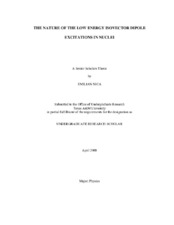| dc.creator | Nica, Emilian | |
| dc.date.accessioned | 2011-08-04T14:41:18Z | |
| dc.date.available | 2011-08-04T14:41:18Z | |
| dc.date.issued | 2011-08-04 | |
| dc.identifier.uri | https://hdl.handle.net/1969.1/98375 | |
| dc.description.abstract | Calculations of the nuclear response function for the Isovector Giant Dipole Resonance (IVGDR) have been carried out in the past using the discretized Hartree-Fock Random Phase Approximation (HF-DRPA). In many cases they contained violations of self-consistency and a large smearing parameter. To avoid any sources of error we carried out a self-consistent HF-Continuum RPA (HF-CRPA) to determine the IVGDR response function in 60Ca, 28O and 80Zr. We have also examined the free p-h response in the continuum. In addition, we determined resonance energies through the phase shift method for 60Ca and 28O. The main goal of our research was to establish if the low-lying peaks in the response function were due to resonance or particle threshold effects. We have shown that in some cases the enhancements in the response function at low energies are due to threshold effects. We emphasize that in a discretized HF-RPA these peaks are spurious and are due to the discretization of the single-particle continuum. | en |
| dc.description.sponsorship | Undergraduate Research Scholars Program | en |
| dc.format.medium | electronic | en |
| dc.language.iso | en_US | |
| dc.subject | Nuclear Collective Excitations, Giant Resonance, Hartree-Fock Random Phase Approximation, Phase Shift | en |
| dc.title | The Nature of the Low Energy Isovector Dipole Excitations in Nuclei | en |
| dc.type | Thesis | en |
| dc.type.genre | Thesis | en |
| dc.type.material | text | en |
| dc.format.digitalOrigin | born digital | en |


